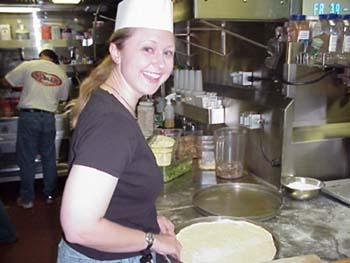11 August, 2002
The 3000 meter stations always take longer and give people a little time to
catch up. Of course, if you are the one sampling or waiting for the CTD to
come up, you have to remember that it will take approximately three hours
from the deck to the bottom and back up again. So, even though your time in
between sampling is longer, your time actually working might easily be
longer as well. We ended up with great cores this morning, but the entire
process took nearly seven hours from beginning to end. It was interesting
to stand on deck and look out at the nearly ice free water around us. Only
the icicles dropping off the equipment reminded us that we are indeed still
in the Arctic Ocean.
I first met Ari Balsom when I visited Jackie Grebmeier's lab at the
University of Tennessee in Knoxville. Ari is a research technician and
graduate student at UT Knoxville, and she has worked with Jackie and Lee
Cooper on two previous cruises to the Arctic. On this SBI spring cruise,
Ari is working for Ken Dunton a professor at the University of Texas in
Austin. When I asked Ari about the focus of her work she said, "You are
what you eat!" Ari is taking large water samples from shallow depths in
order to filter them and get POM (Parcticulate Organic Matter). That means
that her filters will be covered with tiny parcticles when she is done. The
filters will be preserved and analyzed (with a mass spectrometer) for two
isotopes, carbon-13 and nitrogen-15. The carbon 13 concentration can tell
you where that carbon came from, whether it was from the ocean (marine) or
from land (terrestrial). On an interesting side note, Ari told me that
carbon-13 is a very common "tracer." For example, archaeologists who study
Aztec remains can use the carbon-13 in those remains to tell them when the
Aztecs started eating cultivated corn!
Ari is also taking zooplankton and benthic animal samples (we always sieve
one core for Ari) to see how much carbon-13 has made it to the bottom. Once
again, these samples can be analyzed to tell if what the animals are eating
comes from a marine or a terrestrial source. Essentially, the analysis of
carbon-13 helps us to figure out where the carbon in the organisms and in
the water comes from.
Nitrogen-15 gets more concentrated (there's more of it) the higher up you go
on the food chain. By analyzing the nitrogen-15, you can identify the
organism's trophic level (where it fits on the food chain). It will tell
you who's eating what and who is eating whom. Jackie and Lee are both
analyzing the same tracers in the sediment samples we take, but the samples
Ari wants are only from the fresh material on the surface of the mud. In
summary, Ari's work for Ken Dunton includes filtering water to bring back
the preserved filters with their POM (Parcticulate Organic Matter),
identifying and drying zooplankton to be brought back to the University of
Texas, and identifying and preserving benthic organisms for later analysis.
Each time we bring up cores or van Veen grabs, we always take three small
samples of surface mud from the top 1 centimeter (less than ½ inch) for Ari.
These samples are for a different purpose. Ari will analyze them herself to
see how the populations of bacteria and viruses change in the sediments as
we move from the shelf to the slope and down into the basin. She will use a
procedure that she has adapted for use in the Arctic where this work is
rarely done. Bacteria are nature's recyclers. They break down dead organic
matter and return nutrients and other materials to the environment.
Bacteria are tiny but viruses are even tinier! Viruses get inside bacteria
and use the materials in the bacteria in order to reproduce more viruses.
When the bacteria finally split open and all the viruses are released,
nutrients are released back into the water as well. You can see how
important it is to understand more about how these two organisms relate.
It's all a part of the effort to understand the "microbial (micro = tiny and
bio = life) loop" in the ocean. Remember Rex and Matt's work with bacteria
(see the journal for July 26) and you can see how it all fits together. As
with other topics, there is little known about these populations in the
Arctic Ocean. Scientists aren't even certain if the bacteria and viruses
living in the sediments are independent communities or if they are settling
out from the water above. These are just two more important questions that
scientists on this cruise are working to answer.

<> Ari is obviously a woman of many talents. She's seen here helping us cook for the Saturday evening morale dinner.

<> Ari Balsom spends a good deal of her time working at her microscope to identify the organisms she gets from us (from the sediments) and from those who sample the zooplankton. In addition, she collects lots of surface water to filter for POM (Parcticulate Organic Matter).
Contact the TEA in the field at
.
If you cannot connect through your browser, copy the
TEA's e-mail address in the "To:" line of
your favorite e-mail package.
|
